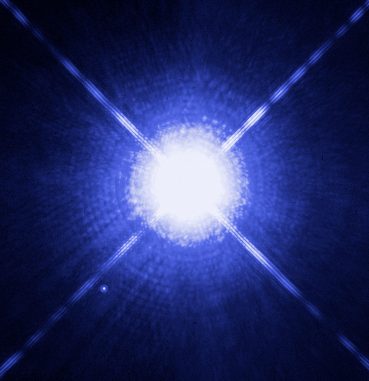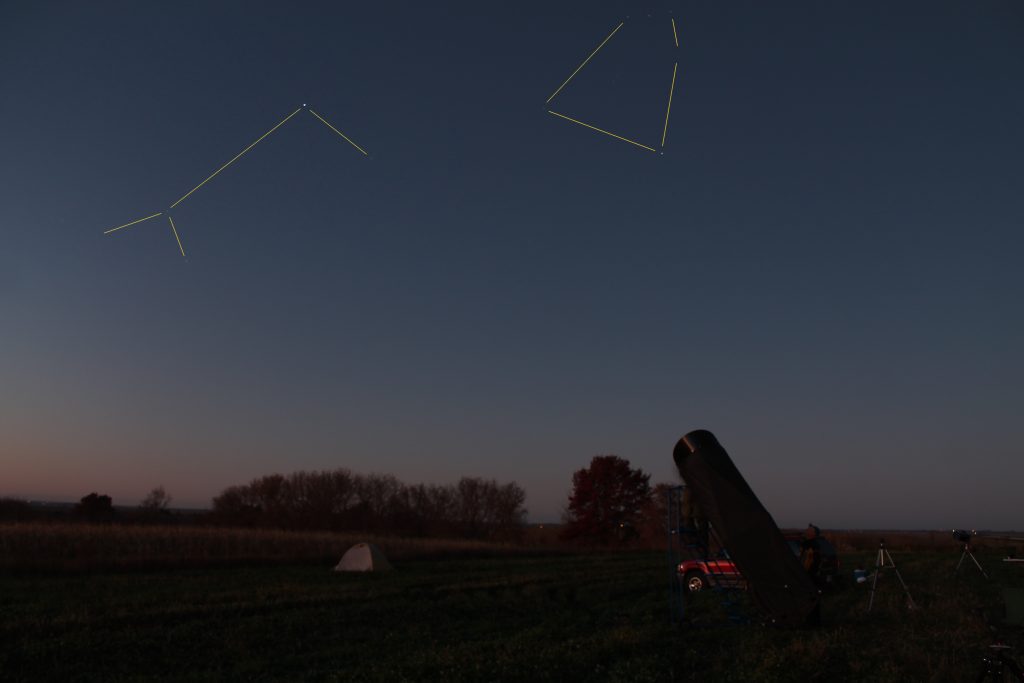
On the 7th annual Star_BQ Sunday morning October 26, 2014 Dean Johnson had an idea to look at Sirius B. At first I didn’t understand what Dean was talking about, why should we look at bright Sirius. I realized later that he meant Sirius B, a weak companion of the brightest star in the sky, which only a few people had the opportunity to see. Randy entered Sirius into his 30″ Dobson and it turned from Jupiter to Sirius; we brought the ladder close to the eyepiece and after a while Randy reported that inside of one of the diffraction rays of Sirius A, Sirius B was faintly visible. Really? After a while I climbed on the ladder to the eyepiece at a magnification of 300 and I saw, in one of the diffraction beams next to bright Sirius of magnitude -1.4, a faint star of the eighth magnitude: Sirius B.
Approximately 10,000 times fainter than Sirius A.

Meanwhile, Dean tried to find Sirius on an increasingly bright sky in his 11″ Celestron Schmidt-Cassegrain telescope on the Orion SkyView Pro equatorial mount and he soon reported that he saw Sirius B as well. I looked into his telescope for a long time, but saw nothing, until I suddenly saw a faint star, quite far from the well formed bright dot of Sirius A. The moment felt the same as searching for Venus or Jupiter in a bright twilight sky and then suddenly seeing the planet. It was like a dream. I’ve often read in literature how an observation of Sirius B is challenging, and now I’ve seen Sirius B twice in two different telescopes. The distance between the two Sirius components is about 10-arc seconds. Sirius B in 1994 was at pericenter, its angular distance is growing since and in 2019 Sirius B was in at apocenter, 11.4” from Sirius A. Due to the orbit inclination from the Earth’s vantage point, the greatest observational separation will occur in 2023, with an angular separation of 11.333″.
Dean Johnson used to organize annual Star_BQ. Mostly a two day event for astronomers on a farm field south of Spring Grove with barbeque afternoon and deep night observation overnight.

| Object | Right Ascession | Declination | Magnitudes | Separation | Position angle |
|---|---|---|---|---|---|
| Gamma Andromedae | 02h 03m.9 | +42° 20′ | 2.3, 5.0 | 9.6″ | 63° |
| 1 Camelopardalis | 04h 32m.0 | +53° 55′ | 5.8, 6.8 | 10.4″ | 309° |
| 55 Eridani | 04h 43m.6 | -08° 48′ | 6.7, 6.8 | 9.3″ | 319° |
| Beta Orionis – Rigel | 05h 14m.5 | -08° 12′ | 0.3, 6.8 | 9.7″ | 202° |
| 12 Lyncis | 06h 46m.2 | +59° 27′ | 5.4, 7.1 | 8.9″ | 309° |
| N Hydrae (17 Crateris) | 11h 32m.3 | -29° 16′ | 5.6, 5.7 | 9.6″ | 210° |
| Omicron Ophiuchi | 17h 18m.0 | -24° 17′ | 5.2, 6.6 | 10.8″ | 355° |
| Gamma Delphinus | 20h 46m.7 | +16° 07′ | 4.4, 5.0 | 9.0″ | 265° |
| Diameter[inch] | 4 | 6 | 8 | 10 | 12 | 20 | 30 |
|---|---|---|---|---|---|---|---|
| Resolution[arc sec] | 1.1 | 0.76 | 0.57 | 0.46 | 0.38 | 0.23 | 0.15 |

This decade is very good to observe Sirius B. You need a telescope, clear night, good seeing, bigger magnification, and of course time. Please, let us know about your experience observing Sirius B.
Links:
https://en.wikipedia.org/wiki/Sirius
https://en.wikipedia.org/wiki/File:Orbit_Sirius_B_arcsec.png
SKY & TELESCOPE: SIRIUS B — A NEW PUP IN MY LIFE
Astronomy League: Double Star Observing Program – PDF
APOD: Sirius: The Brightest Star in the Night
Reflections on StarBQ 2014
